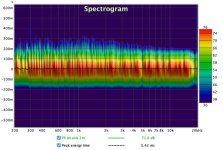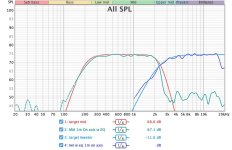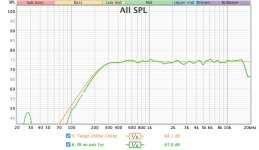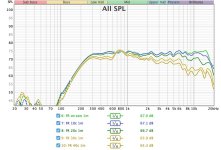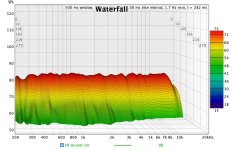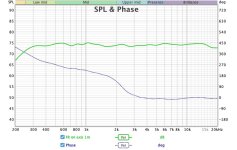My 9sided conical MEH was a successful test of making petal construction on a CNC from flat boards. Unterminated conical horn has some issues - although I measured much less than in simulations.
1. there is ripple in the upper band FR including a quite serious notch slightly above 1.5 kHz
2. there is some narrowing in the mid band that allows only optimization by EQ on a single axis
The issues can be equalized by using comprimised setting to inaudibility or more precisely, not to annoy me while listening.
However knowing they are there forces me to try to do better next time.
Here comes the great free ATH tool by mabat. First, I tried to generate a roundover to add to the existing horn - which reduced the issues in simulations quite considerably, but I could not really get rid of the narrowing, only reduce it. The R-OSSE profile is relatively flat, so iz would allow the following construction in three parts:
1. part - throat adapter with a flange. To improve the directivity and FR on the high end, this time, 1" driver will be used. It must allow 1 kHz crossover at home listening volumes - I measured maximum around 85 dB, A weighted, 100 ms interval, which is already pretty loud. I will allow for 20 dB headroom, which still gives me less than 1 W for a typical 1" driver. It should have low resonance and a short distance between the acoustic center and the front. There is a pretty good choice these days. The adapter will convert the exit angle of the driver and the circular cross section to an octagon.
2. part - flat on the outside, curved on the inside, 8 parts. Mids (4 x 3FE22 most probably) and lows (2x12") will need to fit this part. That is a challenge, since a well simulating horn roundover takes a lot of space. 2x10 or even 4x8" might be needed, otherwise the horn gets too big
3. part - the roundover - to br around 50 mm thick with a flat backside. Mouth diameter will be slightly below 1 meter.
The 3D construction will need more material and would weigh too much, so there will be layered construction and material from outside will be removed where possible allowing to fit damping material as well.
The mids will be placed on the "diagonals" flat parts, the lows on the sides and their enclosures will also serve as a stand.
I have finally found a pretty good profile, generated by ATH. I need to modify the ABEC profile to see how much the performance would be degraded by different back of the waveguide (flat back of the roundover and some mockup of the driver back covers) only as the worst case im circsym.
Another challenge for this construction will be that only a single profile will be used to curve the octagonal walls, so there will still be a difference between round and octagonal. Full 3D round inside may be also possible with the tools at my disposal, so that will be investigated as well.
The quest has been fun so far, over the two rectangular and one round prototype, this one will be most probably very close to the "end game" MEH - unless I find out that full 3D sliced construction is really necessary (like Joseph Crowe's Nighthawk series).
The progress will be documented here, please wish me luck and any input and constructive criticism is welcome🙂
1. there is ripple in the upper band FR including a quite serious notch slightly above 1.5 kHz
2. there is some narrowing in the mid band that allows only optimization by EQ on a single axis
The issues can be equalized by using comprimised setting to inaudibility or more precisely, not to annoy me while listening.
However knowing they are there forces me to try to do better next time.
Here comes the great free ATH tool by mabat. First, I tried to generate a roundover to add to the existing horn - which reduced the issues in simulations quite considerably, but I could not really get rid of the narrowing, only reduce it. The R-OSSE profile is relatively flat, so iz would allow the following construction in three parts:
1. part - throat adapter with a flange. To improve the directivity and FR on the high end, this time, 1" driver will be used. It must allow 1 kHz crossover at home listening volumes - I measured maximum around 85 dB, A weighted, 100 ms interval, which is already pretty loud. I will allow for 20 dB headroom, which still gives me less than 1 W for a typical 1" driver. It should have low resonance and a short distance between the acoustic center and the front. There is a pretty good choice these days. The adapter will convert the exit angle of the driver and the circular cross section to an octagon.
2. part - flat on the outside, curved on the inside, 8 parts. Mids (4 x 3FE22 most probably) and lows (2x12") will need to fit this part. That is a challenge, since a well simulating horn roundover takes a lot of space. 2x10 or even 4x8" might be needed, otherwise the horn gets too big
3. part - the roundover - to br around 50 mm thick with a flat backside. Mouth diameter will be slightly below 1 meter.
The 3D construction will need more material and would weigh too much, so there will be layered construction and material from outside will be removed where possible allowing to fit damping material as well.
The mids will be placed on the "diagonals" flat parts, the lows on the sides and their enclosures will also serve as a stand.
I have finally found a pretty good profile, generated by ATH. I need to modify the ABEC profile to see how much the performance would be degraded by different back of the waveguide (flat back of the roundover and some mockup of the driver back covers) only as the worst case im circsym.
Another challenge for this construction will be that only a single profile will be used to curve the octagonal walls, so there will still be a difference between round and octagonal. Full 3D round inside may be also possible with the tools at my disposal, so that will be investigated as well.
The quest has been fun so far, over the two rectangular and one round prototype, this one will be most probably very close to the "end game" MEH - unless I find out that full 3D sliced construction is really necessary (like Joseph Crowe's Nighthawk series).
The progress will be documented here, please wish me luck and any input and constructive criticism is welcome🙂
For the 1", a Beyma CP380m can play down to 800hz with no problems at home (and even at pro audio levels and durations but may be a pushing it for that). If the throat adapter is a conical extension like Mabat recommends on the ath topic, 800hz will be even easier. I have worked with it on two projects and really liked them.
With 10" woofers things are pretty tight, there is no chance to fit 12" there. I might be forced to use 8", they would fit fine. I will have to check the maximum SPL and low end cutoff with my favourite Fane Sovereign 8-225s.

If you mean cover on the back, then it will most probably stay like pictured - each woofer will have its own box. Only if more volume would be needed, I would make a box as small as possible to fit everything inside - it might be a simple rectangular box or an octagonal for cleaner looks. It also depends on how cleanly can I glue all the parts together.
After some very approximate Hornresp simulations, a pair of 8" Sovereigns should easily exceed my SPL target and allow crossover to subs below 150 Hz, which is still acceptable.
I measured my Runt clones for the first time today and it makes me actually think if I really need the mids - the 8" with a solid 1" driver like BMS4550 can easily do a crossover between 700 - 1000 Hz. And I could most probably fit 4 of them on the horn. For this project, I will be buying new HF drivers anyway and since I cannot fit the 12" woofers I have, also the woofers with have to be bought.
I was also thinking 8" with mids will not be so great with the smaller mids already there, too much overlap and not enough lows.
So I suggest, you may either keep the smaller mids and cross around 200hz or maybe omit them and get 12" woofers with the coax and try crossing at 800hz and make the horn play lower.
An example from my own build. I have used viawave srt7 with two scanspeak 10f/8424 in a synergy horn project designed by Joseph Crowe and built and slightly modified by me. I can not give too many the details because of his ip but my build is different then what he did with it himself. He used the mids on the sides whereas I used on top and bottom inside the horn. Mine is also active with dsp (hypex 252 and a 501 for the bass section but the fr response is not included below). The horn can be crossed around 200hz and have good behaviour and sound.
The mids have no filters in passband, it is all acoustic filtering but I added a high pass for power handling around 120hz and also a lowpass after the notch. There is a notch filter around 770hz on mids, I can not remember if I had some more, I have to look into hfd file. The srt7 has also mostly a high pass filter and as far as I remember a notch filter around 2khz.
I like this build but I am planning on building another one that can play lower and have more efficiency.
Here are some gated results from my build taken at 1m, these do not cover everything but give you the idea;
So I suggest, you may either keep the smaller mids and cross around 200hz or maybe omit them and get 12" woofers with the coax and try crossing at 800hz and make the horn play lower.
An example from my own build. I have used viawave srt7 with two scanspeak 10f/8424 in a synergy horn project designed by Joseph Crowe and built and slightly modified by me. I can not give too many the details because of his ip but my build is different then what he did with it himself. He used the mids on the sides whereas I used on top and bottom inside the horn. Mine is also active with dsp (hypex 252 and a 501 for the bass section but the fr response is not included below). The horn can be crossed around 200hz and have good behaviour and sound.
The mids have no filters in passband, it is all acoustic filtering but I added a high pass for power handling around 120hz and also a lowpass after the notch. There is a notch filter around 770hz on mids, I can not remember if I had some more, I have to look into hfd file. The srt7 has also mostly a high pass filter and as far as I remember a notch filter around 2khz.
I like this build but I am planning on building another one that can play lower and have more efficiency.
Here are some gated results from my build taken at 1m, these do not cover everything but give you the idea;
Attachments
Last edited:
The 770hz and 2khz notch filters are not active on measurements! I did put them into use when I was tuning for the room.
That is a great performance. I tried 12" woofers with GRS PT2522 at the throat in the green horn (https://www.diyaudio.com/community/...pt2522-tweeter-faitalpro-3fe22-mids.400527/)- turning off the mids and modding the crossover. It measured pretty well, but something did not sound completely right - the mids definitely made a difference even when doing a quite narrow band. I need to try that again and maybe build a small mock up to test the various woofer options - including port shape and distance.
I am not sure if I need to go lower than 150 Hz. I tried to simulate the directivity of the horn down to 20 Hz and this is how it looks like:

The inspiration for this project comes from A for Ara:

I do not have enough space to fit the horns like this into a wall of sound, that is why I need to use freestanding plus bass unit.
Talking about the bass unit, I have no idea what to use and where to cross to it so that it would match the directivity of the horn in the midbass. Maybe open back H frame woofers would work...I do not know. I can always go sealed with EQ with one 18" or up to two 15" per side.
I am not sure if I need to go lower than 150 Hz. I tried to simulate the directivity of the horn down to 20 Hz and this is how it looks like:
The inspiration for this project comes from A for Ara:
I do not have enough space to fit the horns like this into a wall of sound, that is why I need to use freestanding plus bass unit.
Talking about the bass unit, I have no idea what to use and where to cross to it so that it would match the directivity of the horn in the midbass. Maybe open back H frame woofers would work...I do not know. I can always go sealed with EQ with one 18" or up to two 15" per side.
I think I have a solution to the problem. I did a quick simulation with the cheap Hadex 165 mm woofer - 8 of them. And it looks promising, 115 dB at 80 Hz is no problem with sealed back, lower would be possible with some boost traded for maximum SPL. At my current listening levels, the Behringer A800 hardly flashes the first indicator light even with boost while using 9 of these in the 9Syn. Simulation of a mock up simulation in Hornresp:

Hornesp is pretty cool, during the simulations I have found out that the peak above cancellation notch in the 9Syn was caused by low chamber volume. For mids, I always tried to get them as close as possible to the throat with minimum chamber volume - it seems the opposite is actually better for the LF - as far away as possible and higher chamber volume. Also, the port length seems to better longer for the LF - so I will definitely try some 3D printed port extensions in the chamber.
Hornesp is pretty cool, during the simulations I have found out that the peak above cancellation notch in the 9Syn was caused by low chamber volume. For mids, I always tried to get them as close as possible to the throat with minimum chamber volume - it seems the opposite is actually better for the LF - as far away as possible and higher chamber volume. Also, the port length seems to better longer for the LF - so I will definitely try some 3D printed port extensions in the chamber.
It turned out that if I wanted to use curved walls, there would be just too much material needed. At the cost of more complexity, it could be build from flat boards similar to the Sabourin horn from Troy Crowe - maybe in 4 or 5 step approxomation of the curve.
- Home
- Loudspeakers
- Multi-Way
- The quest for ATH generated (R-OSSE) free standing round/octagonal MEH
